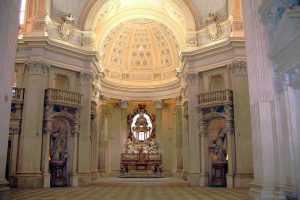The Hall of Diana lies at the heart of the Palace by the same name, where visitors once arrived after crossing the entrance yard and the court of honor.
Immediately below are seven of the original twelve huge equestrian portraits of the Dukes of Savoy and their courtiers by various painters. In the lower register are ten paintings by Jan Miel on the theme of the hunt (hunting the stag, the hare, the bear the fox, the wild boar; the death of the stag; the woods; the gathering before the hunt; the chase; the curea or curing after the kill).
In the 17th century, sumptuous receptions and balls were organized in the Hall of Diana, which lies at the crossroads of Castellamonte’s perspective view that starts from the old town center to the east and continues across the hall and 1,5 km to the west into the Gardens. It also marks the middle point of the line that runs from the start of Via Maestra in the old town center of Venaria to the end of the Central Alley in the Gardens, where the Temple of Diana once stood.
The Castle of La Mandria
Surrounded by the lush greenery of the Park of La Mandria, the royal apartments of the Borgo Castello provide a fascinating connection between the natural environment and the Reggia. Bound to the destiny and the history of the Reggia di Venaria until the 19th century, the Castle of La Mandria became the personal retreat of Vittorio Emanuele II of Savoy in 1859.
The beautiful Royal Apartments that are visible today were built in front of the Castle, which was the most significant building present in the Park.
The apartments consist of 20 rooms that offer insights into the choices and the tastes of the king. Now open to the public, they paint an intriguing portrait of this charismatic figure of the Italian Risorgimento. It was at the Castle of La Mandria that the king spent part of his personal life with his morganatic wife, Rosa Vercellana (known as “Bela Rosin”), who was made Countess of Mirafiori and Fontanafredda.
The Royal Apartments are fully furbished and contain precious objects, artworks, textiles, furniture and furnishings from ancient Savoy collections that allow visitors to appreciate the taste of the first king of Italy.
Royal Palace of Venaria
Reggia di Venaria Reale is a former royal residence and gardens located in Venaria Reale, near Turin in the Metropolitan City of Turin of the Piedmont region in northern Italy. With 80,000m² in palace area and over 950.000m² in premises, it is one the largest palaces in the world. It is one of the Residences of the Royal House of Savoy, included in the UNESCO Heritage List in 1997.
Restored to the baroque magnificence to which it was inspired in the mid-1600s by Duke Carlo Emanuele II of Savoy, the Reggia di Venaria is once again a symbol of modernity and culture. Since its opening in 2007, after two centuries of neglect and decay and eight intense years of restoration, La Venaria Reale has become one of Italy’s five most visited cultural sites.
The monumental palace is home to some of the finest examples of universal Baroque: the Hall of Diana designed by Amedeo di Castellamonte, the Great Gallery and the Church of St. Hubert, the grandiose complex of the Juvarra Stables designed by Filippo Juvarra in the 18th century, the sumptuous decorations and spectacular Fountain of the Stag in the Court of Honor are the ideal setting for the Theatre of History and Magnificence, the permanent display devoted to the House of Savoy that takes the visitor down a path that is almost 2,000 m long, from the basement level to the piano nobile of the Reggia.
Seen from above, the Reggia and the Gardens cover a surface of 950,000 square meters of unencumbered architecture and parkland. They lie at the heart of a vast estate that is made up of the Juvarra Stables (a 5,000 sq.m. exhibition centre in the Citroniera and the Great Stables); the Conservation and Restoration Center (housed in the former Alfieri Stables); the Old Town Center, the Borgo Castello and Cascina Rubbianetta (today home to the prestigious International Horse Center) set among the woods and castles that dot the 6,500 hectares of greenery in the nearby Park of La Mandria.
The Gardens appear today as a perfectly balanced combination of ancient and modern elements, in a boundless scenario where archaeological findings and contemporary artworks dialogue in harmony. A complex restoration project has led, over a period of eight years, to the reconstruction of the landscape and its historical landmarks that also took into account modern aesthetics and contemporary needs with important art works by the contemporary masters Giuseppe Penone and Giovanni Anselmo.








